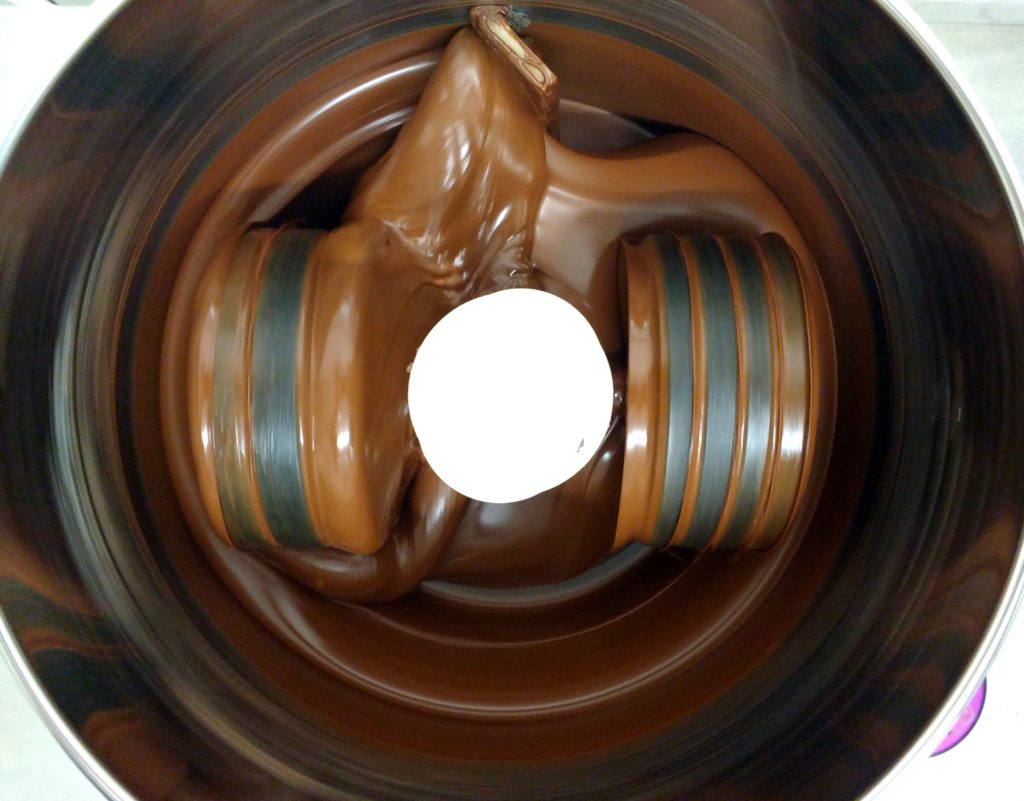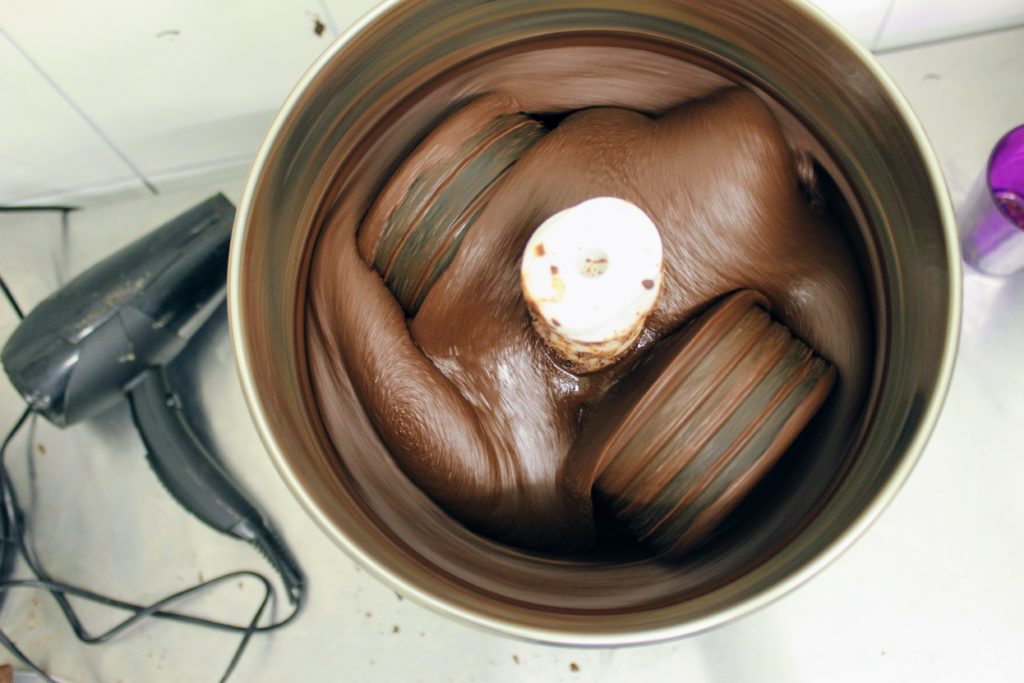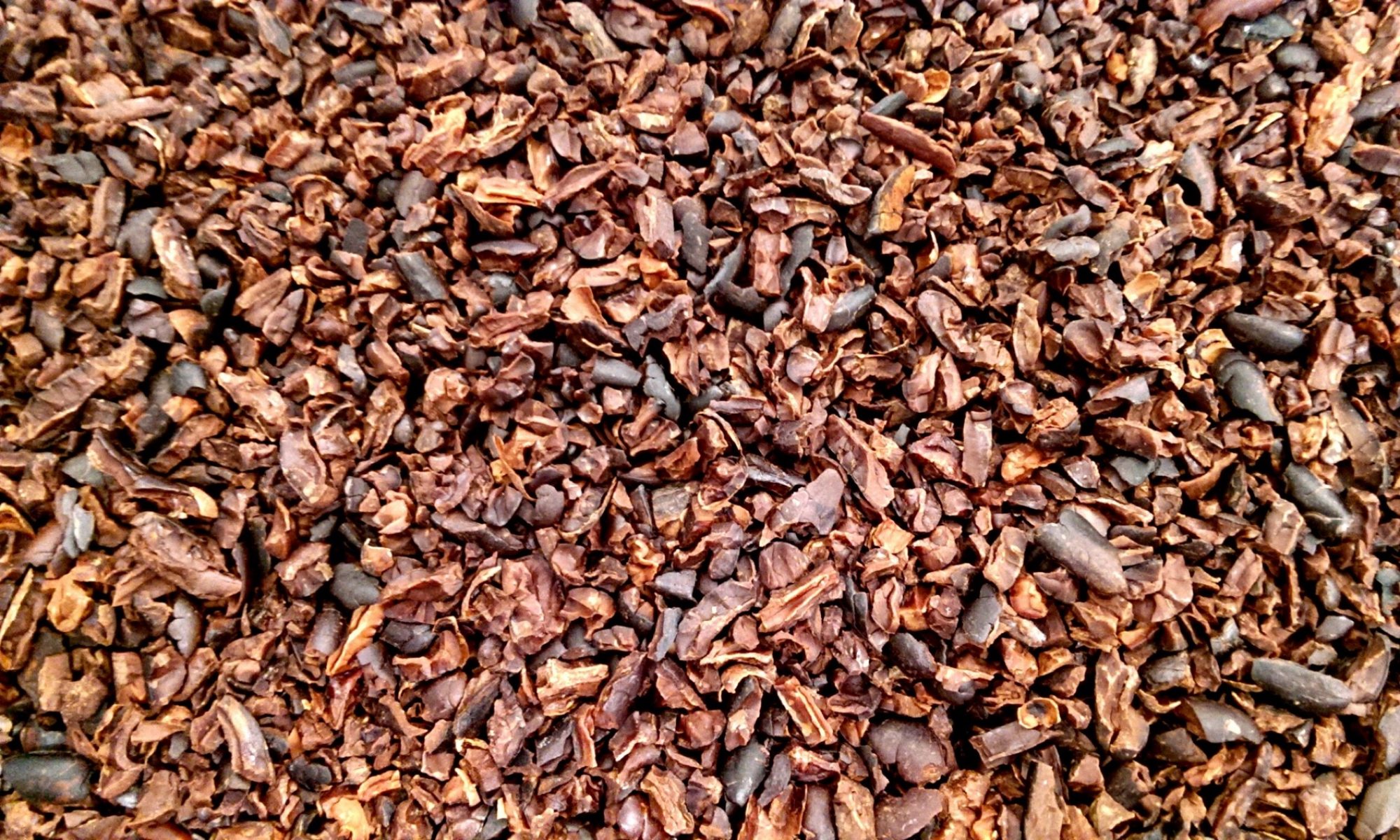
Commercially produced chocolate is made using a wide variety of equipment that is often beyond the reach and requirements of small chocolate makers. Most industrial chocolate producers will use large capacity roll refiners or ball mills to refine cocoa mass and other ingredients, often combining those with a separate conching stage. For those producing chocolate by the ton, the efficiencies of scale these machines provide mean they are often the only way a commercial confectionery product can be made.
Craft chocolate makers will often use a large melanger (a large metal drum with a granite base and rotating granite wheels) for their production. These machines generally have a capacity of 20 to 50 kilograms and are significantly less expensive that industrial chocolate making machinery. They combine a reasonably high output with minimal space requirements, and some would argue produce a better quality chocolate than large machines.
For those making chocolate on an even smaller scale, tabletop versions of these melangers are the go-to choice. With capacities of up to 3kg, they are extremely affordable, easy to use, and able to produce chocolate that can rival the best in the world.
Tabletop melangers are perfect for small craft chocolate makers and hobbyists alike. But they are also an invaluable product development tool for large producers. It’s much better to learn about your ingredients and make your mistakes in a 3kg batch in your kitchen than a 500kg batch in a commercial factory.
Pitfalls & Potential Dangers
While they are a great solution for small scale chocolate production, tabletop melangers are not without their problems and potential dangers.
Making a batch of chocolate in a melanger can take 24 hours or more, and that often means leaving the equipment unattended. If the motor fails, a batch of chocolate will quickly solidify, and similarly if the chocolate becomes too thick or something gets into the bowl or mechanism, the motor can be damaged.
There have been several cases of fires in chocolate factories using melangers, including one in my own workshop. Some newer models of chocolate melangers have safety cutouts and temperature sensors, but leaving any equipment running unattended is always a risk.
If you do need to leave equipment running, it’s wise to invest in monitoring equipment. An internet connected camera and smoke alarm can send a notification straight to your phone if something happens while you’re away, but they are no substitute for a properly certified fire alarm.
If you’re making chocolate regularly, it’s worth getting an electrician to test all your equipment. If you’re doing it as a business, it may be a legal requirement to get any equipment tested.
Which Machine Should I Buy?
Premier
When it comes to low cost tabletop melangers, Diamond Custom Machines‘ Premier branded machines are king. These can be picked up for around $200 and are widely available internationally via Amazon.com (US / UK) and other retailers.
There are two main models; a smaller capacity upright model, and a slightly larger capacity machine that can be tipped for pouring out the finished chocolate. What might not be so obvious is that there are two versions of each melanger. The standard version is primarily designed for grinding grains such as rice.
A version fitted with some strengthened parts and a safety cut-off has been produced by American company Diamond Custom Machines and is marketed as the Premier Chocolate Refiner. Although the basic machines are perfectly up to the job of making chocolate, I do recommend investing in the upgraded models, simply as they are likely to last a little longer and be a little safer when operated for extended periods. They are not significantly more expensive than the unmodified versions, but are more than worth it for the extra peace of mind.
Cocoa Town
Cocoa Town are more well known for their larger capacity “Grindeur” machines, but they do also make smaller versions including the Abi 10 Melanger. The small Cocoa Town machines are not as widely used as the Premier Chocolate Refiners, but some makers do still use them for recipe development and lab tests.
Santha
American company Santha produces a smaller melanger called the Spectra 11, which is quite popular there. Santha are less well known outside the US, but there machines are available in both 110 volt and 220 volt variants.
One thing to note about the Santha machines, is that they are designed with the motor next to the bowl rather than below it. Because of this, they take up more counter top space than the Premier machines.
Unbranded / Chinese Machines
As small scale chocolate production becomes more popular, Chinese factories have started producing low cost equipment under a variety of brands. You may find these machines for sale on sites like Amazon, eBay and Aliexpress.
My advice is always to be wary when considering electrical equipment imported directly from China. It may be impossible to get technical support or spares, but more importantly they may not have been produced to local safety standards for electrical goods. I would advise against buying a brand you haven’t fully researched, but if you do, be sure to get it checked by a qualified electrician before plugging it in.
Whichever machine you buy, always make sure that it is designed to operate at local voltages and get it checked before using it if you are at all unsure.
Using The Melanger
Making chocolate in a tabletop melanger isn’t complicated. Simply add your ingredients and let the machine run for 24 hours or so. But there are a few things you need to keep in mind for the process to go smoothly.

Firstly, it’s important that your recipe has enough fat (i.e. cocoa butter). Too little and your chocolate will be too thick and the melanger will have trouble refining it. It’s important to make sure that your initial recipe has enough fat content (around 30% minimum), and that there is always enough in the machine at all times. If you start the refining process by adding all the sugar and no cocoa nibs and cocoa butter, you’ll put undue stress on the motor.
Cocoa nibs are around 50% fat by weight, so a good way to start your batch is with the cocoa nibs. Add them slowly, and as they refine down the fat will be released. Heat from the friction of the granite wheels will melt the cocoa butter and the nibs will turn first to a paste, then into a thick liquid relatively quickly.
During the early stages of production, it’s a good idea to give the heat a helping hand with a heat gun or hair dryer. You can gently pre-warm the bowl and alternate between adding nibs and heating. It’s important not to get the bowl too hot as you risk burning the chocolate, or damaging the machine itself. The temperature of the metal bowl should be warm, but never too hot to touch.
If your production space is relatively warm, the heat from friction should be self sustaining and you shouldn’t need to add further heat after the first half hour or so.
Once all the cocoa nibs are in the machine and starting to behave like a thick liquid, you can start to add other ingredients such as sugar and milk powder. The order you add these ingredients will not significantly affect the finished chocolate, but as with the cocoa nibs it’s important not to add them too quickly.
If the machine starts to struggle, it’s likely because you’re adding ingredients too quickly. Pause for a while and let the machine refine what’s in there before adding more. Adding a little extra heat may also help.
If your recipe calls for added cocoa butter, it’s best to pre-melt it. This can be done in a heat proof bowl or jug in a very low oven, or melted in a microwave if you’re careful. Melted cocoa butter can be added slowly at the same time as sugar and milk powder in order to keep the batch flowing freely.
If you’re adding flavours to your chocolate, it’s usually best to add them towards the end of the refining process. This is because the conching process can drive off some of the flavour components that you want to keep.
You may also find that some ingredients like dried fruit powders are sticky and can for clumps if added directly to melted cocoa butter. Adding fruit powders after other dry ingredients can mean that the “sticky” particles have something else to stick to rather than clumping together, reducing the likelihood for larger lumps forming and producing a smoother chocolate.
One of the best pieces of advice for making great chocolate is simply to go slow when adding ingredients. Rushing to get all the ingredients in puts undue stress on the machine and makes it more likely the whole process will grind to a halt. It’s far better to take a little extra time to let ingredients refine down and add an extra hour or so to your total grind time than it is to try to get everything going as quickly as possible.
What’s Happening Inside The Machine?
The melanger is doing a couple of different things during the chocolate making process. Firstly, and most obviously, it’s refining the ingredients. Large cocoa nibs and sugar crystals are ground down into smaller and smaller particles over time. These solid particles are suspended in the liquid cocoa butter. As long as the particles are small enough, the finished chocolate will have a smooth texture. If the chocolate feels grainy when tested, it can usually be refined further by leaving it for longer or tightening the pressure of the wheels on the granite base.

The second process that’s happening is conching. The heat generated by friction and rapid movement of the chocolate help to drive off volatile chemicals and develop the flavour. Conching for longer can reduce bitterness, but if you over-conche you run the risk of driving away the subtle natural flavour notes in your cacao.
Because the refining and conching processes are happening at the same time, it’s difficult to control both processes separately. This is one of the downsides of using a melanger over a separate refiner and conche, but with practice (and good quality cacao) it’s perfectly possible to produce world class chocolate using a melanger.
Cleaning Your Melanger
If you’re only making one type of chocolate, there’s no need to fully clean your machine between every batch. The cleaning process inevitably wastes some chocolate, so as long as your working environment is clean, it’s perfectly fine to do two or three batches before doing a thorough clean.
That said, if you’re making different recipes, particularly if you’re using allergens or switching from making milk chocolate to dark, it’s very important to clean the melanger thoroughly before starting a new batch.
Cleaning your melanger is a relatively simple task. Once emptied, the bowl can be washed with warm water and mild detergent. Try to get as much chocolate out of the bowl prior to washing so as to minimize the amount that goes down the drain. The cocoa butter in chocolate is bad for the environment and can quickly clog pipes if you’re making chocolate regularly.
When washing the wheels, remove them from the axles if possible. During production, chocolate can build up between the wheel and axle and it’s important to thoroughly clean everything to avoid contaminating subsequent batches.
Maintenance
Most small melangers are quite rugged and do not require significant maintenance beyond keeping them clean. Although they can be disassembled for cleaning and maintenance, check with the operating instructions before undergoing maintenance as you may void warranties, damage the equipment or injure yourself. Keep in mind that spare parts may not be readily available, especially for cheaper machines. If a melanger fails, it is often easier to simply purchase a new one. Older machines can be recycled or kept for spares.
Summary
Tabletop melangers such as the Premier Chocolate Refiner are a great way of making micro batch chocolate for the hobbyist and small craft chocolate maker alike. They’re simple to use, easy to maintain and cheap to purchase. They have opened up the art of chocolate making to a whole new audience, which can only be a good thing.
Twenty years ago, almost all chocolate was made by a handful of multinational companies on a huge industrial scale. It’s largely thanks to the availability (and repurposing) of cheaper equipment that it has become possible to make chocolate on a small scale and even at home. Tabletop melangers are just the start of the chocolate making revolution. With new innovations such as home ball mills on the horizon, perhaps in another twenty years we’ll all be making our own chocolate at home in the same way we drink coffee now.
